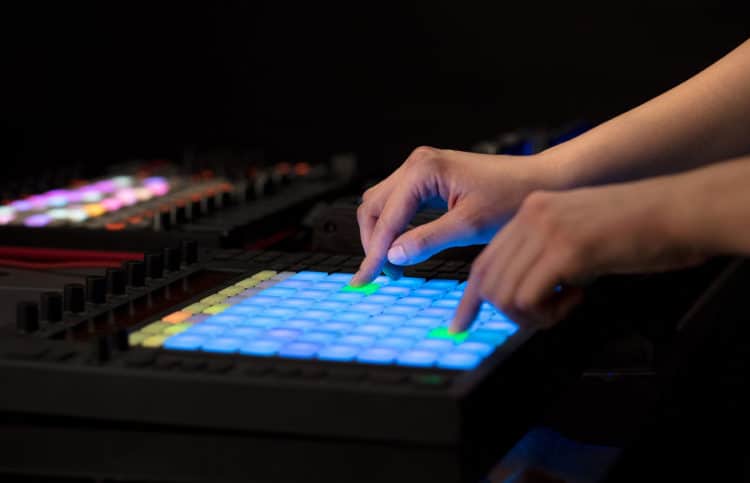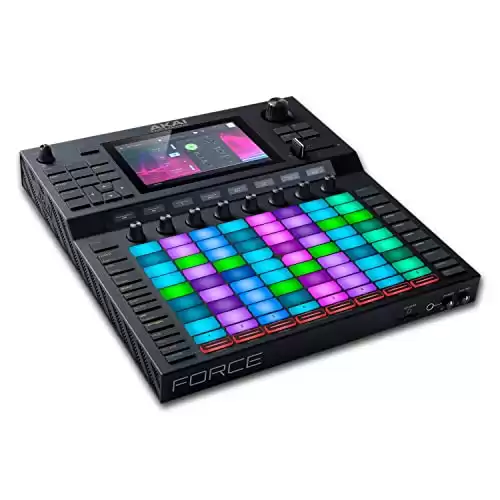When creating electronic music, the two most popular choices to use today are USB and MIDI controllers. This option can be used with an instrument directly, through an audio pickup, or through adapters and converters.
If you’re serious about creating the perfect sound, it’s important to know the differences between these two options.
Although both are useful for DAW recording, most musicians find that one option works better for them than the other.
Difference between USB and MIDI Controllers
USB controllers can send large data packets, including real-time audio. This information also includes details specifics about the product. MIDI only sends small data packages, or practical instructions about the notes to play, timing, and velocity through a five-pin connection.
When comparing USB controllers to the MIDI option, you’ll find three critical comparison points to review.
- MIDI controllers can tell the DAW when to start and stop notes, make prog changes, and consider timing and velocity. There is no other information sent.
- USB controllers deliver detailed controller information, including any sound samples you might have created locally with an instrument.
- Although both are real-time options, a MIDI must use a five-pin connection. USB has the typical connection for flash drives, charging chords, and similar uses.
Although it seems on the surface that USB is the best choice, there are some reasons why MIDI is a superior option.
Most instruments (especially keyboards) have both connections to let you make music without limitations. A few entry-level designs might force you to select one over the other.
| Why Choose USB Over MIDI? | Why Choose MIDI Over USB? |
| USB is a faster choice, creating fewer delays and less lag when playing an instrument. By playing in real-time, you’ll get a feeling of what the composition sounds like more experientially. | This option lets you use vintage equipment and sounds while producing modern music with today’s best DAW. The MIDI-in and MIDI-out create the same two-way communication as USB. |
| If you’re using keyboards or controllers built after 2010, this option is almost universally accepted. It’s only when you use something older that compatibility issues can enter the equation. | Since MIDI is an older technology, it’s often more affordable than USB. New instruments typically include this option as a secondary feature so that it’s usable in most situations. |
| Almost everything that MIDI is capable of doing is an option with USB when choosing the right channel. | Many portable synths and pocket instruments only use MIDI for connections because of their overall size and lower cost. |
Most musicians want the best of both worlds today. Although that means you won’t get to run Volca FM units if you only use USB, there’s plenty of alternatives to review that can lead you to your signature sound.
How to Use MIDI in Your Music
MIDI never transmits an audio signal to your DAW. When you have this connection with your software, the information sent to it creates a note roll that translates to an audio pickup. That’s why there can be a lag in a low-speed connection.
The note played must be transcribed by the software into an audible sound. Once that happens, it’ll transmit to your speakers or headphones.
If a MIDI keyboard doesn’t have an onboard sound source, such as a sampler or a synth, it doesn’t have the capability to create sound.
That’s how this connection can become part of your workflow. MID clips are the timeline regions that control what notes the plugins play and when. You’re feeding data to a virtual instrument that delivers real-time results.
When using a MIDI connection, you can do the same thing with a drum machine or an analog synth.
The most significant benefit of this approach is that you can quickly edit your performance.
Most DAWs let you change the note length, pitch, and register with a couple clicks of the mouse. That means most of the features from a traditional performance have a MIDI equivalent.
You can even use the messaging from MIDI to automate parameters, change hardware patches, or manage software effects.
What Are the Main MIDI Channel Messages?
The beautiful part of using MIDI for making music is the simplicity it offers. You’ll find that its main channel messages, including systemic ones, deliver the right amount of information to create an accurate composition.
Here is what a standard MIDI setup delivers to a DAW when connected to a keyboard, synth, or another compatible instrument.
- It tells what notes are depressed and released, including the velocity of each action.
- Aftertouch registry is sent in the data packets, noting the pressure of the held keys after they’re depressed.
- Control changes register parameter alterations on the device.
- Program changes offer info about the different patch numbers on the device.
- Channel pressure is useful for noting how much is applied across all depressed keys.
If you have a pitch bend lever or wheel on your keyboard or instrument, the system messages control the changes made to each sound based on your actions. These work with the system messages to understand if there’s a need to communicate with each other.
As for the MIDI system messages, you’ll transmit timing clock data, transport information, and system exclusive options. Older instruments rely on the latter extensively to share information.
When your instrument has a MIDI sequencer, it can store information and manage your playback. This option includes editing and recording, making it one of the most common user methods for this controller.
Isn’t MIDI Outdated for Modern Music?
Some musicians feel that MIDI is outdated in every regard. I would disagree with that sentiment. Although USB has a larger bandwidth, MIDI offers a serial connection at 31250bps. Unless you’re using a dirt-cheap connection, the audio remains clean and distributed.
Where I might agree is when you need portable power. MIDI has no power transfer capabilities, but a USB connection might have enough juice to let your keyboard operate without an outlet nearby.
If ground loops are a problem, MIDI is still the best choice. USB encapsulates the MIDI data with a bus protocol into dedicated clients and hosts. It won’t get rid of the issue, but a simple, high-quality MIDI cord still works.
What MIDI Synth Should I Use for My Music?
The best MIDI synth to use for music production today is the AKAI Professional FORCE standalone model. It’s a high-capacity DJ performance system with a seven-inch, full-color capacitive multitouch display.
The 8×8 clip launch matrix features standard RGB LEDs to create a visually exciting setup.
Users can record audio through the dual XLR inputs with phantom power or opt for instrument-level support. The audio routes to two stereo outputs or your preferred headphones.
You can hook all the studio equipment to the FORCE. It delivers MIDI In, Out, and Thru with its capability to integrate live and studio performance setups.
You’ll also get dual USB 3.0 slots for thumb drives or MIDI controllers, 16 GB of onboard storage, and a full-size SD card slot.
Is USB Only a Viable Option for Making Music Today?
When musicians want to plug directly into a PC or MAC, they don’t need MIDI capability for the DAW.
You could opt for an ethernet interface instead, but that option generally costs $200 more than the USB interface.
It’s also easier to install most USB instruments, especially since the average PC has several ports to use.
The one disadvantage of the USB-only design is that you have limited spatial capabilities. MIDI cords can be significantly long, allowing the musician to have more flexibility with instrument placement and movement.
When you have an ethernet connection for an instrument, the cable length can be up to 300 feet. Most USB lines are within six feet or less. That’s why laptops and tablets are commonly used when producing music with this option.
Best Traditional Synth to Use for Music
When I want to take a traditional approach to music, I lose USB and MIDI for an analog synth. You’ll see me on the stage with the Behringer CRAVE Synthesizer instead because of its legendary fat music.
You won’t believe how insane the sounds are that come from this unit. The Prophet five-star VCO gives you a pure signal path on VCF and VCA, while the impressive oscillator delivers sawtooth and pulse wave outputs for plenty of personalization.
What stands out the most is the ladder filter from Mook with resonance, ensuring that you always sound great. There’s a switchable high and low pass filter mode for additional enhancements.
When you’re ready for sequences, this Behringer design offers a 32-step option that works with its 64 onboard storage slots.
Your music will sound like it came straight out of the 1980s, but with a fresh take on synth pop like something released in the past couple of years.
There’s even a noise generator included to dramatically expand your waveform generation capabilities.
Although the Behringer synth is a monophonic instrument, the poly-chain function lets you combine multiple synthesizers for up to 16 voices.
You’ll notice impressive stability with this option, especially when comparing it to the older models.
A Final Thought on USB vs. MIDI Controllers
PCs have never had a genuine MIDI port. They’ve relied on adapters that work with the joystick. The problem with a MIDI-only setup in that situation is that most converters can be more of an obstacle with the routing. Only if you need a long cable is MIDI the better option over USB for musicians.
I’ve used MIDI for stage work a lot during my live performance days because it was easy to create connections. Since the maximum length for a USB 2 connection is only 16 feet, that’s not enough space to operate with an entire stage.
When you talk about an upgrade to USB 3, you get maybe ten feet to use for cabling.
I’ve had successful playing options at 40 feet with MIDI, although I’ve found about 20 feet typically gives you a better connection.
Some musicians look at wireless connections, such as Bluetooth, to replace the cable. I’ve always found the timing to be off by enough that it bothers me when playing.
I’ve found a lot of good tunes with the AKAI Professional FORCE. If you make one investment this year in your music, that’s the direction I’d recommend going. It gives you home recording and stage performance capabilities.
For something more traditional on the stage, I’d stick with the Behringer CRAVE synth.




